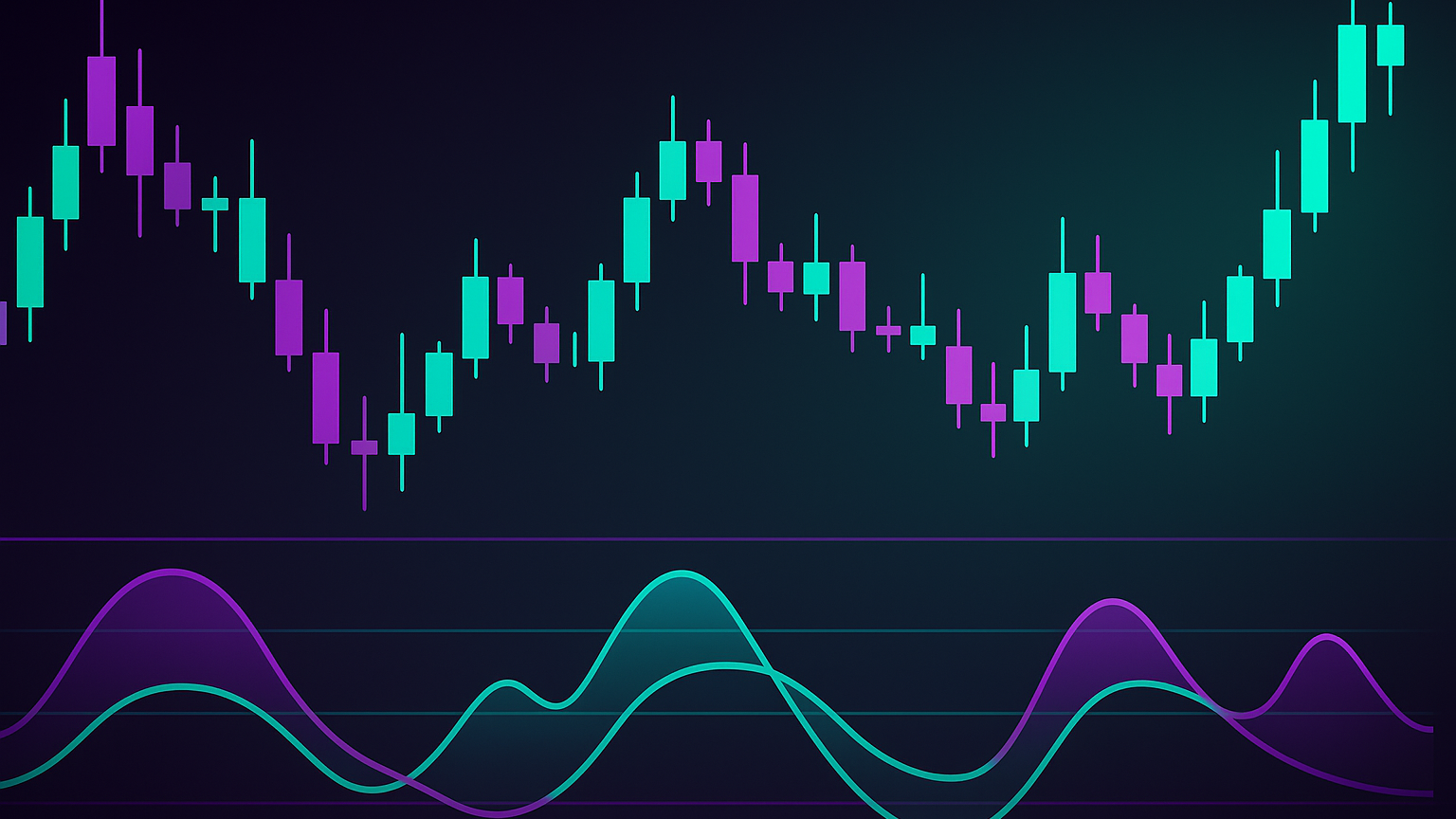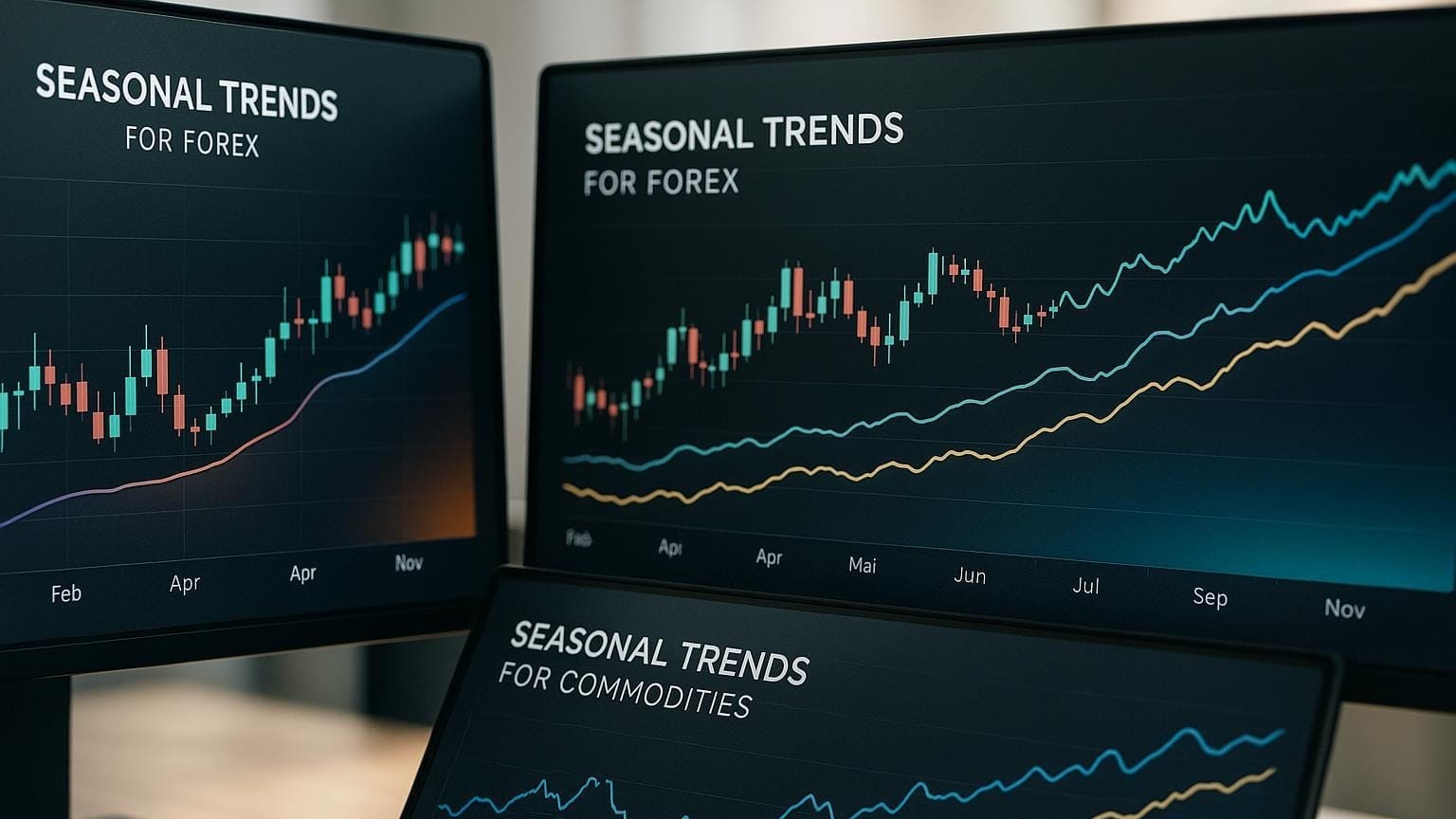Understanding market regimes is essential for traders to tailor their strategies for success, enhancing returns while managing risks effectively.
Market regimes are the distinct "states" or "moods" of financial markets - like bullish trends, bearish declines, or volatile swings. Understanding these patterns is critical for traders because each regime demands a tailored strategy for success. For example:
- Trending Markets: Trend-following strategies work best.
- Sideways Markets: Mean‑reversion strategies thrive here.
- High Volatility: Short‑term tactics like scalping are effective.
- Low Volatility: Long‑term investing or gradual trend‑following strategies perform well.
Key tools to identify regimes include technical indicators (like ADX, RSI, and MACD), price action analysis, and advanced statistical models such as Hidden Markov Models (HMM). Platforms like LuxAlgo simplify this process by offering AI-powered backtesting and regime‑detection tools, ensuring strategies align with current market conditions. The right strategy, matched to the correct regime, improves results and reduces risks.
Market Regimes The Secret to Understanding (and Beating) Any Market!
4 Main Types of Market Regimes
Grasping the key market regimes is crucial for traders to identify the current environment and fine‑tune their strategies. Each regime brings its own set of opportunities and challenges.
Trending Markets: Bull and Bear Trends
Trending markets are defined by clear directional movement. In a bull market, prices consistently climb, supported by positive sentiment and strong fundamentals, creating higher highs and higher lows. Conversely, bear markets see prices steadily drop, forming lower highs and lower lows. Trend‑following strategies, such as moving average crossovers, tend to perform well in these conditions. However, traders need to stay alert for pullbacks that could disrupt the trend. On the other hand, sideways markets require a completely different approach.
Sideways Markets: Range‑Bound Conditions
Sideways markets occur when prices move back and forth between established support and resistance levels, without forming a clear trend. In these conditions, mean‑reversion strategies can be effective, as traders aim to profit from price bouncing within the range. However, false breakouts - when prices briefly move outside the range but fail to sustain the direction - can pose a significant challenge. Patience and precision are essential, as the profit potential tends to be smaller compared to trending markets.
Volatility Regimes: High vs. Low Movement Periods
Volatility regimes refer to the intensity of price swings and can influence any type of market trend.
High‑Volatility Markets are characterized by sharp price swings, increased uncertainty, and significant movements [2]. The Cboe Volatility Index (VIX), often called the "fear gauge", is a widely used measure of market volatility [3]. For instance, VIX values above 25 typically indicate conditions where mean‑reversion strategies are more viable [5]. As Andrew Prochnow, Luckbox analyst‑at‑large, puts it:
"In volatile markets, fortune favors the prepared - those with a well‑defined approach to both risk and opportunity." [3]
During high‑volatility periods, traders can benefit from tighter stop‑loss orders, smaller position sizes, and short‑term strategies like scalping or day trading [1]. Tools such as the Average True Range (ATR) are useful for assessing the magnitude of price swings.
Low‑Volatility Markets feature more subdued price movements, narrower trading ranges, and a generally stable environment [4]. When the VIX drops below 15, the market often becomes more conducive to trend‑following strategies [5]. These periods typically reflect calm economic conditions with fewer major news events. Strategies that focus on gradual price changes, like options trading or long‑term investing, tend to work well. Traders might opt for wider stop‑loss levels and consider larger position sizes.
| Feature | High Volatility | Low Volatility |
|---|---|---|
| Price Movement | Rapid swings | Mild fluctuations |
| Trading Strategies | Scalping, day trading | Options trading, long‑term investing |
| Market Sentiment | Uncertainty, fear | Stability, consensus |
| Risk Management | Tighter stop‑loss, smaller positions | Wider stop‑loss, potential for larger positions |
| VIX Level | Above 25 | Below 15 |
Shifts between volatility regimes often signal major changes in market dynamics. Traders who monitor these transitions closely and adjust their risk management strategies accordingly are better equipped to adapt. Recognizing these regimes is essential for choosing the right trading approach, a topic explored further in the next sections.
How to Identify Market Regimes
Spotting market regimes involves blending technical tools, price analysis, and pattern recognition to align trading methods with the current conditions.
Technical Indicators for Regime Detection
Technical indicators turn raw market data into visual cues that help traders make more informed decisions. Combining trend, momentum, and volume indicators - like ADX, RSI, Aroon, and MACD - can help reduce false signals.
Trend Strength Indicators are key for distinguishing between trending and range‑bound markets. The Average Directional Index (ADX) measures the strength of a trend, regardless of its direction. If the ADX is above 40, it signals a strong trend, making it ideal for trend‑following strategies. Conversely, readings below 20 suggest weak trends or range‑bound conditions, better suited for range‑trading strategies.
The Aroon indicator highlights the start or end of trends by tracking the time since the highest and lowest prices occurred. Pairing Aroon with volume indicators can help confirm trend changes and reduce the chances of false signals.
Momentum Oscillators identify overbought and oversold conditions. The Relative Strength Index (RSI) is particularly useful for gauging market extremes and trend strength. RSI readings above 70 indicate an overbought market that may decline, while readings below 30 suggest oversold conditions, signaling a potential rally. The MACD (Moving Average Convergence Divergence) is another versatile tool, combining trend and momentum analysis and highlighting divergences between price action and indicator movement.
Price Action and Market Structure Analysis
Price action captures real‑time price movements and offers direct insights into market regimes without the lag associated with many technical indicators.
Market Structure Basics focus on three market states: uptrend, downtrend, or sideways consolidation. Uptrends are defined by higher highs and higher lows, while downtrends feature lower lows and lower highs. Sideways markets lack a clear direction and typically move within set ranges.
Trend Pattern Recognition involves spotting impulsive moves and pullbacks. Recognizing these patterns helps traders pinpoint entry and exit opportunities, assess momentum, and spot potential reversals. Multi‑timeframe analysis can reveal early signs of regime changes that might go unnoticed on a single timeframe.
Key Structural Concepts like Change of Character (CHoCH) and Break of Structure (BoS) are crucial for identifying shifts in market sentiment. A BoS confirms trend continuation, while CHoCH suggests possible reversal. Observing CHoCH can prompt traders to tighten stop‑losses or prepare to exit positions.
Advanced Methods: Statistical and Algorithmic Approaches
Hidden Markov Models (HMM) estimate the probability an asset will continue similar behavior or jump to another state. In research published on QuantConnect, Louis Szeto demonstrated an intraday trading strategy on the top ten market‑cap stocks that delivered a 36% return with a Sharpe ratio of 1.7 and a maximum drawdown of 7.3%.
Regime‑Switching Models dynamically adjust portfolio exposure based on detected market conditions. Machine‑learning approaches take regime detection further by incorporating macroeconomic variables. For example, random‑forest models using data like the Consumer Price Index and unemployment rates explained up to 96.75% of the variance when forecasting high and low uncertainty states.
| Method | Best For | Complexity | Key Advantage |
|---|---|---|---|
| Technical Indicators | All trader levels | Low to Medium | Real‑time signals, widely available |
| Price Action Analysis | Intermediate or Advanced | Medium | Direct market reading, minimal lag |
| Statistical Models | Advanced or Institutional | High | Quantitative precision, advanced pattern detection |
Matching Trading Strategies to Market Regimes
Aligning your trading strategy with the current market environment is absolutely critical. A mismatch between strategy and market type can turn potential gains into frustrating losses.
Strategy Selection by Market Type
In trending markets, the goal is to ride extended price movements. Trend‑following strategies rely on tools like moving averages, MACD, and Ichimoku clouds to confirm trend strength. In range‑bound markets, mean‑reversion strategies shine, while breakout strategies are ideal during transitional phases when the market shifts regime.
| Strategy Type | Best Market Conditions | Win Rate | Holding Period | Stop‑Loss Requirements |
|---|---|---|---|---|
| Trend Following | Strong trending markets | 20‑40% | Long‑term | Tight stops, 1.5‑2% risk |
| Mean Reversion | Range‑bound markets | 80‑85% | 2‑10 days | Wider stops for temporary moves |
| Breakout | During regime transitions | Variable | Short‑term or intraday | Relatively tight stops |
Common Mistakes and How to Avoid Them
Using one strategy across all environments, ignoring volatility shifts, failing to adapt positions, and overtrading without proper filtering are frequent pitfalls. Traders can avoid these mistakes by maintaining regime awareness, employing strict risk controls, and filtering setups through volume confirmation and multi‑timeframe analysis.
Using LuxAlgo AI Backtesting for Market Regime Strategies
The AI Backtesting Assistant accesses a massive database of over ten million backtested strategies, helping you pinpoint what works best in specific market environments. The system evaluates your chosen assets across different timeframes and conditions, then reveals the optimal parameters long before you risk real capital.
Optimizing Entry, Exit, and Risk Management
Once you have historical insights, LuxAlgo's AI optimizes stop‑loss placement, position sizing, and profit targets. In high‑volatility periods it suggests reduced size, while in calmer markets it widens stops to prevent premature exits.
LuxAlgo Tools for Regime Detection
The LUCID (LuxAlgo Universal Conditions Identifier) system combines three powerful toolkits - Signals & Overlays, Price Action Concepts, and the Oscillator Matrix - to create strategies that respond dynamically to shifting market conditions. Features like volumetric order blocks and configurable alerts enable data‑driven adaptation.
Practical Tips for Trading Different Market Regimes
Monitor Market Conditions Regularly
Market regimes can change gradually or suddenly. Real‑time trading alerts act as an early warning system. Configure alert intervals and daily limits according to the table below:
| Market Condition | Alert Interval | Daily Alert Limit |
|---|---|---|
| Trending | 5‑15 minutes | 15‑20 |
| Ranging | 30‑60 minutes | 8‑12 |
| High Volatility | 1‑5 minutes | 20‑25 |
| Low Volatility | 60+ minutes | 5‑8 |
Adding minimum price‑movement thresholds can help refine alerts. For instance, use a 1% threshold in trending markets, about 1.5% for range‑bound or low‑volatility conditions, and as low as 0.5% during high volatility.
Use Multiple Strategies, Not Just One
Diversifying approaches prepares you for sudden transitions and ensures you can handle a variety of scenarios. Trend‑following strategies often excel during strong directional moves, mean‑reversion techniques perform best in ranges, breakout strategies thrive during regime shifts, and volatility‑based models adapt to fluctuating market energy.
Combine Regime Detection with Backtested Strategies
Integrating real‑time regime detection with backtested methods strengthens your trading framework. Link current market conditions with historically successful strategies, then review and adjust performance monthly to ensure alignment.
Conclusion: Trading Success Through Market Regime Awareness
Why Recognizing Market Regimes Matters
Identifying market regimes turns trading into a process grounded in analysis rather than guesswork. Tailored strategies have been shown to enhance risk‑adjusted returns by 10‑30% while also cutting drawdowns by a similar margin [6][11].
How LuxAlgo Tools Can Help
Start with regime‑classification indicators in the Price Action Concepts, Signals & Overlays, and Oscillator Matrix toolkits. Then leverage the AI Backtesting platform (included in the Ultimate plan) to optimize each regime’s settings and keep your strategy effective as conditions change.
FAQs
How can I use LuxAlgo's tools to identify and adapt to market regime changes in real time?
LuxAlgo's real‑time analysis of volatility, momentum, and trend direction highlights shifts quickly. By blending these live signals with backtested strategies on the AI Backtesting platform, you can switch between trend‑following, mean‑reversion, or breakout approaches as conditions demand.
What are the common mistakes traders make when their strategies don’t match current market conditions, and how can they avoid them?
Traders often stumble by failing to adapt their strategy, overtrading in unsuitable environments, or neglecting risk management when volatility shifts. Staying regime‑aware, using disciplined risk controls, and filtering setups through volume and multi‑timeframe confirmation help avoid these pitfalls.
How can backtesting with LuxAlgo improve trading strategies for different market conditions?
Backtesting with LuxAlgo lets traders evaluate how their strategies perform in trending, ranging, or volatile markets. Historical testing refines entry, exit, and risk parameters so that live trading matches the prevailing regime.
References
- Trending Market Toolkit - LuxAlgo Library
- Market Structure Intrabar - LuxAlgo Library
- Price Action Concepts - LuxAlgo Library
- LuxAlgo Home
- AI Backtesting Features - LuxAlgo Blog
- Moving Average Converging - LuxAlgo Library
- Support & Resistance Dynamic - LuxAlgo Library
- Range Average Retest Model - LuxAlgo Library
- Market Sentiment Technicals - LuxAlgo Library
- Fetching Strategies - LuxAlgo Docs
- AI Backtesting Platform - LuxAlgo
- Backtester S&O - LuxAlgo Library
- Volumetric Order Blocks - LuxAlgo Docs
- Signals & Overlays Alerts - LuxAlgo Docs
- Backtester Alerts - LuxAlgo Docs
- Earn2Trade - Adapting to Market Conditions
- tastylive - Volatile Markets Strategies
- Medium - Volatility Regimes
- HighStrike - Adjust Strategy
- FundYourFX - Low Volatility Markets
- QuantConnect Research
- Wikipedia - Consumer Price Index
- TradeWithThePros - Real Time Alerts
- TradeKaiju - Monitoring Market Conditions
- Smart RIA - Trade Monitoring
- StatOasis - Mastering Market Regimes
- Pollinate Trading - Regime Strategies








